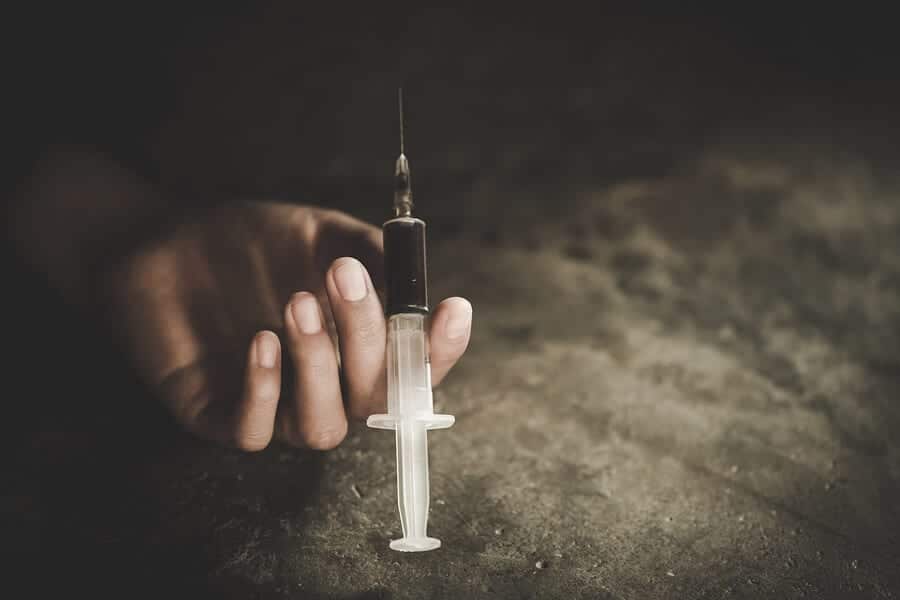
Is Heroin a Stimulant? – No, heroin is not classified as a stimulant. It is a potent central nervous system (CNS) depressant. It is an illicit, highly addictive semi-synthetic opiate drug derived from morphine, a compound found in the opium poppy. Heroin is usually found as a white to brownish color powder that is laced with sugar, starch, powdered milk, quinine, or synthetic opioids such as fentanyl.
Pure heroin is white and has a bitter taste. Common methods of administration include smoking, snorting, and injecting. Another form of heroin called “black tar” is a dark, sticky, highly impure substance that is subject to crude processing methods and is often dissolved and injected.
Heroin’s Effects on the Body
Heroin works by attaching to and activating specific receptors in the brain known as mu-opioid receptors. Our brains have naturally occurring chemicals called neurotransmitters that attach to these receptors throughout the brain and body. These neurotransmitters control pain, regulate hormone release, and induce feelings of well-being, when appropriate.
When opioid receptors are activated in the brain’s reward center, they initiate the release of dopamine, a neurotransmitter responsible for pleasurable and rewarding feelings. This effect can result in a reinforcement of drug-using behavior. Consequences of heroin use then depend on a variety of factors, including how much was used and for how long, how the drug was administered and the speed at which it reaches receptors, among others.
Is Heroin a Stimulant?: Short-Term Effects
Once heroin reaches the brain, it is then converted back to morphine and quickly binds to opioid receptors. People who use heroin usually report feeling a rush of pleasurable sensations, the intensity of which is influenced by the aforementioned factors. The rush of heroin is usually accompanied by a warm flushing of the skin, and a heavy feeling in the extremities. Adverse effects include nausea, vomiting, and severe itching.
After the initial rush, users will probably be sedated and drowsy for several hours. During this time, mental function is clouded, heart rate is reduced, and respiration can slow down to the point of being life-threatening. Perilously slow breathing can also result in coma and irreversible brain damage.
Is Heroin a Stimulant?: Long-Term Effects
Repeated heroin use alters the physical structure of the brain, as well as the manner in which it functions. This alteration leads to chronic imbalances in neuronal and hormonal systems that are not easily reversed. Research has shown that some deterioration of the brain’s white matter can result from heroin use, which can impair decision-making capabilities, affect a person’s ability to regulate behavior, and adversely alter responses to stress.
Over time, heroin use also produces profound degrees of tolerance and dependence. Tolerance occurs when increasingly larger amounts of a drug are required to achieve the desired effects. With physical dependence, the body becomes accustomed to the presence of a drug, and withdrawal symptoms onset if use is suddenly reduced or discontinued.
Heroin Withdrawal

Withdrawal symptoms can manifest within just a few hours after the last dose of heroin. Symptoms of withdrawal include the following:
- Teary eyes
- Runny nose
- Restlessness
- Muscle and bone pain
- Insomnia
- Diarrhea
- Nausea
- Vomiting
- Chills and goosebumps
Initial heroin withdrawal symptoms peak between 24–48 hours after the last dose and wane after about a week. However, some people have shown persistent psychoemotional withdrawal signs for several months after detox.
Prolonged heroin use often leads to a heroin use disorder—a condition akin to an addiction, which is considered to be a chronic, relapsing disease. Addiction includes physical dependence but is additionally characterized by compulsive drug-seeking in spite of the incurrence of severe, adverse consequences.
Heroin is profoundly addictive regardless of how it is administered. Still, methods of administration that allow the drug to enter the brain the fastest (e.g., injection) increase the risk of progressing to heroin use disorder. Once a person has developed heroin use disorder, seeking and using the drug becomes a top priority in their lives.
Medical Complications of Long-Term Heroin Use
Method of administration notwithstanding, chronic heroin users will encounter a wide range of health complications, including insomnia and constipation. Lung problems, including various types of pneumonia and tuberculosis, may result from the user’s poor health and reduced immunity, as well as from heroin’s ability to dramatically depress respiration.
Many heroin users also suffer from mental health disorders, such as depression. Males often experience sexual dysfunction, and menstrual cycles in women may become irregular. There are also consequences associated with the different methods of administration. For example, people who regularly snort heroin can damage the nasal tissues and those who inject often incur sores and abscesses in the skin.
Health consequences of repeated injections also include scarred or collapsed veins and bacterial infections of the blood vessels and heart. Many of the adulterants in street heroin may be substances that do not easily dissolve, and this can result in blockages in the blood vessels that lead to the lungs, liver, kidneys, and brain. These blockages can subsequently result in infection or the death of small batches of cells in vital organs.
The sharing of unsterile injection paraphernalia or fluids can lead to some of the most serious health consequences of heroin use. Intravenous heroin use increases the user’s risk of contracting infections such as hepatitis B and C, HIV, or any number of other blood-borne viruses.
Overdose

It can be difficult to determine if someone is overdosing on heroin. Passing out or nodding off are common indicators of heroin use. People who suffer from an overdose often report that it feels like a stronger rush of calmness or heaviness than they are accustomed to experiencing. You can tell that someone is probably experiencing an overdose if he or she passes out shortly after using heroin or loses consciousness more rapidly than usual.
Additionally, cold and clammy skin, bluish skin around the fingernails or lips (cyanosis), shallow, slow, or labored breathing, and a weak pulse are clear indications of a heroin overdose. People who don’t respond to painful stimuli, such such as light pinching or pressure on their breastbone, have probably overdosed. If you or someone you know exhibits any of these signs after using heroin, make sure you or another person call 911 immediately.
What to Do for an Overdose
After calling 911, if the person isn’t breathing, perform rescue breathing or CPR. After providing 2-3 rescue breaths, administer Narcan (naloxone) if it is available. Avoid doing anything that may place the person at risk for other health complications. Trying to revive a person by any method other than CPR or administering naloxone can put them at a heightened risk for other health problems:
- Do NOT attempt to reverse the effects of heroin by using a stimulant such as coffee, cocaine or meth
- Do NOT shake them or attempt to force them to wake up
- Do NOT place them in a cold bath or shower
- Do NOT try to induce vomiting
NOTE: If you use heroin or other opioids or you know someone who is at high risk for an opioid overdose, talk to your health care provider or pharmacist about obtaining naloxone. This lifesaving drug is available over the counter in most states, and some organizations provide free access to the medication.
Treatment for Heroin Addiction
An addiction to heroin is a devastating and possibly life-threatening condition that requires immediate, professional treatment in a specialized facility. Regular heroin users may be one dose away from dire consequences, including coma, permanent brain damage, or death.
Harmony Recovery Center employs a comprehensive approach to addiction comprised of services clinically-proven to be vital for the process of recovery. These services include cognitive-behavioral therapy, counseling, peer support, medication-assisted therapy, aftercare planning, and more.
If you or someone you love is struggling with an addiction to heroin, contact us today. Discover how we help people break free from the cycle of addiction and go on to lead happier, more fulfilling lives!
Related: How Long Does Percocet Stay in Your System?